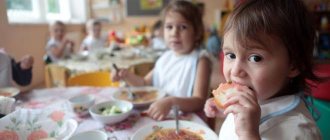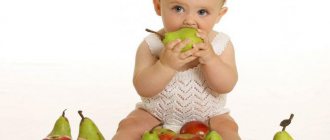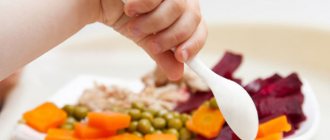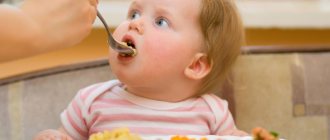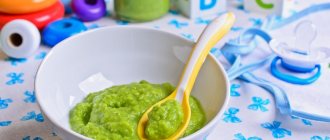With the arrival of a baby in the family, every mother is concerned with the question of whether her baby is getting enough to eat and how much he should eat normally. Pediatricians and child nutrition specialists have developed approximate standards that are only advisory in nature, because all children are individual and develop differently. Therefore, the need for food in children may vary. It depends on the activity of the baby (some of the children are active, while others are calmer); on metabolic rate and constitution. It may even be that one child has a good appetite and remains thin, while the other looks well-fed, although he eats little.
You shouldn’t force a child to eat or come up with various tricks in order to cram in the norm required for his age. Even if the baby eats less than normal, but is cheerful, cheerful and active, then everything is fine with him. His body simply requires less food. If the child weighs less than the age norm, is lethargic and suffers from poor appetite, then he should be examined.
The other extreme is overweight children. As a rule, these are overfed children. A special “merit” in this matter belongs to grandmothers. It should be remembered that by constantly overfeeding a child, you form incorrect eating habits in him: he gains excess weight, which in turn leads to obesity and, consequently, to all the diseases that accompany it.
Veal goulash
What to cook for dinner for a 2-year-old child if he loves meat dishes?
Beef or veal goulash is a great option. The recipe for its preparation is very simple, and the set of necessary products can be found in the refrigerator of any thrifty mother. Ingredients:
- Meat – 500 grams.
- Bulb.
- Tomato paste - teaspoon.
- Flour - a tablespoon.
- Bay leaf.
- Black pepper – a pinch.
- Vegetable oil - two or three tablespoons.
How to cook goulash:
- Select a piece of lean meat and cut it into cubes.
- Peel the onion and cut into half rings. After that, heat it in a frying pan, and at the end add the veal.
- When the meat is browned, pour a glass of water into it and simmer the dish over low heat until cooked.
- Prepare a sauce from 100 ml of water, tomato paste and flour. Pour it into the pan, then add salt and spices to taste. Don't forget to add bay leaf for flavor.
Cook the goulash for a few more minutes. When the sauce thickens, the dish can be removed from the heat and served.
Rules and regulations
Few parents know that the menu in kindergartens is compiled for 20 days, that is, for one school month. At the same time, different menus are prepared for children of different ages. Thus, preschool children's groups are divided into two age categories, based on which the diet is selected:
- the menu for the nursery group for children aged 1.5 to 3 years should include 1540 Kcal per day;
- the menu for the younger, middle and older groups of children aged 3 to 7 years should include 1900 Kcal.
The daily menu includes 4 full meals, between which there should be 3.5-4 hours. And each dish contains a certain amount of proteins, fats and carbohydrates. The caloric content of dishes is of great importance, since food should first of all saturate the body with energy.
In the morning, the children in the group are greeted by the teacher and soon after that, when all the children have gathered in the group, the children sit down at the table. The first meal is breakfast, which contains 25% of the daily calorie intake. Therefore, parents are not advised to feed the child in the morning at home, so as not to confuse the body with one mode and not spoil the appetite. The maximum that can be offered to a child in the morning at home is a mug of tea and a small sandwich with butter.
After short games in the group, a second breakfast follows, which should contain about 10% of the nutritional value. As a rule, children are offered fruit drinks, jelly, light cottage cheese or seasonal fruits.
After a walk in the fresh air and active games on the street, the child needs to have a thorough meal. During lunch, children are offered small portions of salad with fresh vegetables, hot soup, a main course with a side dish and meat or fish, as well as compote and a small dessert in the form of a bun or cookies. The lunch meal makes up about 25% of the energy value.
After sleep, children are offered an afternoon snack - 10% of the daily food allowance. If the kindergarten provides 5 meals a day, including dinner, then the afternoon snack remains light, as does the second breakfast. And if only 4 meals a day are provided, then during the afternoon snack the teachers and the nanny try to feed the child more thoroughly so that he does not feel hungry until he returns home.
Options for dinner in some kindergartens are discussed with parents on an individual basis. For example, if parents take their child home from kindergarten before 17:00, then the child has dinner at home. And if parents most often stay at work until 18:00, then the child receives his last meal in the group. And late in the evening, you can offer your child a small snack before bed, for example, a glass of kefir, fruit, cottage cheese, etc.
The child's transition to adult food should be gradual. The diet is changed as follows: to train the masticatory apparatus, more dense and solid food is introduced, and liquid and semi-liquid food is gradually reduced.
To prevent your baby from turning away from a new dish, try using a simple rule: food should look attractive and smell delicious. It is the aroma and appearance of “goodies” that trigger the process of gastric juice production. By the way, bright dishes will serve as an excellent assistant in this matter.
Make at least one meal a family meal, even if the child’s overall diet does not coincide with yours.
Gradually teach your child to set and clear the table. A three-year-old child can already be asked to wash the dishes.
| Products | Unit. | Quantity |
| Milk | ml | 600 |
| Bread | G | 40 |
| Cereals, pasta | G | 20 |
| Potato | G | 100 |
| Various vegetables | G | 150 |
| Fruits | G | 100 |
| Juices | ml | 100 |
| Meat | G | 60 |
| Fish | G | 25 |
| Cottage cheese | G | 50 |
| Yolk | PC | 0,5 |
| Vegetable oil | G | 4 |
| Butter | G | 12 |
| Sugar | G | 40 |
| Salt | G | 3 |
Serving norm for a 3 year old child
The diet of a three-year-old child should consist of three main meals and one or two snacks. That is, it looks like this:
- breakfast,
- snack,
- dinner,
- snack,
- dinner.
The diet of a three-year-old should include:
- pork, boiled sausage (or frankfurters) - 70 g per day;
- pasta or pancakes/pancakes - 100 g of flour products per day.
The daily food intake should be approximately 1500 ml, the calorie intake should be 1550 kcal/day.
It is not recommended to give chocolate, pickled and smoked foods to children of this age.
Toddlers usually don't eat enough at one meal. Therefore, to feel full, they need snacks between meals. At the same time, snacks should be healthy - consist of low-fat foods (cheese, cottage cheese, yogurt, lean turkey or chicken breast, whole grain crackers, strawberries, peach or apple slices). Do not offer your child a snack shortly before the main meal.
Children's dinner: tips and tricks for parents
Newborn babies are fed in the evening with mother's milk or formula until complementary foods are introduced. During this period, there are no questions about what to cook for the child for dinner. For children over one year old, cook porridge in water or milk, make puree from fresh fruits and boiled vegetables.
Dinner should be light and not feel heavy. Feeding times depend on what time the baby goes to bed. If he goes to bed at 21.00, then he needs to prepare food at 19.00; if he goes to bed at 22.00-23.00, then the last meal can be moved to 20.00.
Food distribution for children:
| Nutrition | % calories |
| Breakfast | 25% |
| Dinner | 40% |
| Afternoon snack | 10% |
| Dinner | 25% |
Nutritionists will tell you what to cook for dinner for children who attend kindergarten and receive good nutrition there. Experts recommend giving natural food that is not thermally processed (fruits and vegetables). For dinner, it is better to offer foods that the child did not get during the day, that is, the food received at home should complement the kindergarten food.
This is not difficult to do, since in garden groups a daily menu is posted (you can check the menu for the week); in some gardens, recommendations are given regarding evening meals at home. For example, if your baby hasn’t eaten a single apple in a day, you can give him a fruit salad for dinner. If there was a shortage of cottage cheese, you can prepare cheesecakes or cottage cheese with dried fruits.
Sometimes children themselves refuse to eat kindergarten food; many parents believe that their children do not eat enough in kindergarten, so they try to feed them more in the evening. As a result, the child overeats, sleeps poorly, the routine gets lost, and health problems appear.
If your baby refuses to eat certain dishes from kindergarten, you need to gradually accustom him to them at home: sometimes cook them for dinner or on weekends. In addition, children's dishes can be decorated in a very funny way, which significantly increases interest and appetite.
For food to be beneficial, it is necessary to follow the fundamental principles of child nutrition:
- The diet must be varied using different dishes and products. It is not recommended to serve the same dish twice. There are different dishes for breakfast, lunch and dinner.
- You need to prepare food yourself, and not buy semi-finished products. This is the only way to be sure of the quality of the products and the shelf life of the dish.
- Food should be high enough in calories so that the child does not have time to get hungry before and during sleep. At the same time, it should not be heavy.
- Food must be safe, this means monitoring the shelf life and storage conditions, and the method of preparation. Finely chop or grind the meat, remove all bones from the fish. The possibility that the child may choke should be excluded.
- Products should be easily absorbed by the child's body. Thus, it takes a lot of time to digest meat dishes, so it is not advisable to include these products for dinner.
- When preparing meals for children, it is necessary to take into account cooking technologies: minimize fried food for children under 6 years of age.
- Follow the diet: you need to eat every 3-4 hours, avoid snacks (drink only).
- Food must be prepared 30 minutes before feeding. You should not give food that has been in the refrigerator for more than 24 hours.
Experts advise listening to the “don’t” rules:
- Do not give too hot or cold food. Food should be warm so as not to burn yourself, and not cold so as not to lose its taste.
- You should not force feed your baby: persuade, force. If a child refuses to eat, it means he doesn’t want to eat. A slight feeling of hunger (if it can be satisfied) is sometimes useful. But if a child refuses soup or porridge, but asks for sweets, you should not please him.
- Do not rush the child: the pace of feeding is an individual quality. Some people eat slowly, some eat quickly. When a child chews food thoroughly and eats slowly, the food is crushed, moistened with saliva and digested better. Pieces swallowed hastily are difficult to digest, entering the intestines and injuring it.
- There is no need to distract from food: turn on cartoons on TV or keep new toys in sight. This is especially true for children with poor appetite: appetite does not increase, but the child develops digestive disorders.
On weekends and holidays, the baby's nutrition should be close to what he receives in kindergarten. To prevent various diseases, you need to fortify your diet: give fresh (preferably homemade) vegetables and fruits, herbs, and freshly squeezed juices for dinner.
Experts recommend keeping a baby food diary. The menu from the kindergarten is included in it daily. This helps to decide on the choice of evening dish.
How to determine if a child is eating enough?
For each year of the child there should be approximately one tablespoon of each type of food. Offer your baby beautifully decorated and delicious food. See how much he will eat without your coaxing or any pressure. Don't force your child to eat everything you serve him. Let him eat as much as he deems necessary to satisfy his hunger. If after eating the child is still hungry, then offer him to eat more.
Don’t threaten or punish your child if he doesn’t want to eat—don’t force him! Do not resort to bribery, offering watching cartoons or dessert as a reward - just to shove at least another spoon into your beloved child.
Do not show your child your concern about his refusal to eat. Sensitively sensing your mood on this matter, children may refuse to eat in order to attract attention to their person from their parents.
Persistently feeding a baby while listening to fairy tales or songs, using threats or persuasion can lead to the fact that in adulthood the child will not be able to determine the level of satiety when hunger has already been satisfied. This behavior quickly leads to excess weight gain and all the health problems that come with it.
Weekly menu for a child 4-5 years old - advice from a nutritionist
› 3-7 › Nutrition › Healthy nutrition for a child aged 4-5 years: a weekly menu from a children's nutritionist
Healthy nutrition for a child aged 4-5 years should be based on the principle of variety and balance. In addition, it is necessary to take into account the age-related characteristics of the functioning of the child’s gastrointestinal tract.
Healthy nutrition for a child, according to our consultant Tatyana Klets, pediatrician of the highest category, candidate of medical sciences, pediatric nutritionist, should also take into account the portion size acceptable for a child at this age. Unfortunately, modern mothers with the best intentions naturally often overfeed their children. Therefore, in her recommendations, Tatyana Klets gives the serving size in grams. Please take note of this!
4 quick and delicious baking recipes for children
A single serving size for a child aged 4-5 years is 450-500 g (including the drink), the cooking method should remain gentle (boiled, baked, stewed dishes), however, 1-2 times a week you can include dishes prepared using frying.
Fatty meats, hot seasonings and sauces (ketchup, mayonnaise, mustard, etc.) are not recommended. You should also avoid products containing artificial additives (dyes, flavors, preservatives, etc.).
), and also do not abuse allergenic products (chocolate, cocoa, citrus fruits).
Indispensable in the diet of children are: milk and dairy products, meat, fish, eggs. Meal times (breakfast, lunch, afternoon snack, dinner) should be constant, time deviations should not exceed 30 minutes. So, an approximate weekly diet:
Monday
Breakfast:
- Oatmeal porridge with milk 200 g
- Bread with butter and cheese 30/5/30
- Cocoa with milk 200 g
Dinner
- Salad (seasonal) 50 g
- Borscht with sour cream 150 g
- Pilaf with meat 100 g
- Rose hip decoction 150 g
- Rye bread 30 g
Afternoon snack
- Curd casserole 200 g
- Honey 30 g
- Kefir 200 g
- Biscuits 30 g
Dinner
- Vegetable stew 200 g
- Chicken ball 100 g
- Cranberry juice 150 g
Tuesday
Breakfast
- Rice milk porridge 200 g
- Quail egg omelette 100 g
- Milk 100g
- Bread with butter and cheese 30/5/30 g
Dinner
- Squash caviar 40 g
- Buckwheat soup with meat 150 g
- Boiled potatoes with butter 100 g
- Fried fish 60 g
- Rye bread 30 g
- Compote 100 g
Afternoon snack
- Natural yoghurt 200 g
- Bun with jam 30/30 g
- Fruits (apples, bananas) 200 g
Dinner
- “Lazy” dumplings with sour cream 250 g
- Tea with milk 150 g
- Canned fruits (peaches) 100 g
Wednesday
Breakfast
- Vermicelli “navy style” 200 g
- Fruit and berry jelly 150 g
- Fruit 100 g
Komarovsky reminded why fast food is dangerous for children and how to reduce harm
Dinner
- Salad (seasonal) 50 g
- Vegetable soup with meat 150 g
- Pearl porridge 100 g
- Meatball 70 g
- Fruit juice 100 g
- Rye bread 30 g
Afternoon snack
- Natural yoghurt 200 g
- Cupcake with raisins 100 g
Dinner
Thursday
Breakfast
- Buckwheat porridge with milk 200 g
- Gingerbread 50 g
- Cocoa with milk 150 g
- Fruit 100 g
Dinner
- Salad (seasonal) 50 g
- Rassolnik with sour cream 150 g
- Stewed potatoes 100 g
- Fish cutlet 60 g
- Fruit and berry compote 100 g
- Rye bread 30 g
The kingdom of sweet gifts: simple and safe recipes
Afternoon snack
- Cheesecakes with sour cream 200 g
- Milk 100 g
- Shortbread cookies 30 g
- Fruit 100 g
Dinner
- Flocked vermicelli 200 g
- Vegetable salad 100 g
- Boiled egg 1 pc.
- Tea with milk 150 g
Friday
Breakfast
- Pancakes with apples, jam 200/30 g
- Fruit 100 g
- Milk 150 g
Dinner
- Salad (seasonal) 50 g
- Chicken noodle soup 150 g
- Boiled rice 100 g
- Boiled tongue 80 g
- Fruit compote 100 g
Afternoon snack
- Cottage cheese with sour cream, jam 200/30 g
- Fruit juice 150 g
- Shortbread cookies 30 g
Dinner
- Stuffed cabbage rolls with meat 200 g
- Vegetable salad 50 g
- Tea with milk 150 g
- Fruit 100g
Saturday
Breakfast
- Millet milk porridge 200 g
- Boiled egg 1 pc
- Fruit 60 g
- Milk 200 g
Dinner
- Salad (seasonal) 50 g
- Pea soup, croutons with garlic 150/30 g
- Buckwheat porridge with butter 100 g
- Steam cutlet 70 g
- Fruit and berry juice 100 g
Afternoon snack
- Yogurt 200 g
- Fruit 150 g
- Butter bun 30 g
TOP 5 important rules for children's breakfast
Dinner
- Vegetable stew, liver 150/100 g
- Hard cheese 50 g
- Milk 150 g
Sunday
Breakfast
- Pearl barley milk porridge 200 g
- Omelette 50 g
- Milk 150 g
- Fruit 100 g
Dinner
- Salad (seasonal) 50 g
- Bean soup 150 g
- Boiled rice 80 g
- Baked fish with lemon 60 g
- Fruit and berry juice 100 g
Afternoon snack
- Milk 200 g
- Shortbread cookies 30 g
Dinner
- Cheesecakes with sour cream, jam 150/30 g
- Fruit 100 g
- Tea with milk 150 g
Children's menu: 6 ideal meat dish recipes for little gourmets
The editors' opinion may not coincide with the opinion of the author of the article.
Dinner
The child should be fed lunch at 12-13 o'clock. Be sure to have a first course: soup, borscht, cabbage soup. For the second course, vegetables are served with a side dish of meat or fish, and light salads.
Sample menu:
- borscht, fish zrazy with rice, pumpkin and apple salad;
- pumpkin soup, chicken tenders with cabbage puree, carrot salad;
- fish soup, mashed potatoes, beet salad;
- broth with noodles, beef stew and vegetable stew, boiled green peas;
- beet and bean puree soup, buckwheat porridge with rabbit cutlet, Chinese cabbage salad;
- soup with meatballs, mashed potatoes with boiled cauliflower, summer salad.
For drinks, it is recommended to give berry or fruit compote, rosehip infusion, freshly squeezed juice, uzvar.
How to create a menu for the week
An individual healthy eating menu will help you get used to eating at a certain time. After all, regular nutrition is the key to food discipline. When creating a menu, focus on your usual daily routine. If you are a “morning person” (you wake up at 6:00 and go to bed at 21:00), follow this nutritional principle:
- breakfast: 7:00;
- second breakfast:10:00;
- lunch: 13:00;
- afternoon tea: 16:00;
- dinner: 19:00.
If you are a night owl (you wake up at 9:00 and go to sleep at 00:00), learn to eat at this time:
- breakfast: 10:00;
- lunch: 13:00;
- lunch: 15:00;
- afternoon tea: 17:00;
- dinner: 20:00.
Distribute the time of meals depending on the regime. But do not forget that you need to have breakfast an hour after waking up (after you get up, drink 250 ml of still water at room temperature), 2-3 hours should pass between meals, and dinner should be no later than two hours before sleep.
Remember: to lose weight, it is important to keep track of the calories you eat. Write down everything you eat without leaving anything out, even if it's a sip of fruit juice or a sugar-free mint
This develops the habit of being careful about what and how much you eat and being able to stop in time.
When planning your weekly menu for weight loss, follow these recommendations:
- Make a separate list of the products you want to add and distribute them by day. For example, it is better to choose different days for chicken and fish.
- Remember that, firstly, you should not skip breakfast, and secondly, it should be nourishing and balanced: 50% of the total daily diet should be carbohydrates, 30% proteins and 20% fats.
- For dinner, eat proteins: cottage cheese (5-9% fat), baked, boiled chicken or fish (hake, pollock, salmon).
- Don't forget about snacks between main meals. Eat fresh fruits (if bananas - then no more than one per snack, if grapes - no more than 200 g), vegetables, dried fruits and nuts (walnuts or unsalted peanuts - no more than 50 g per snack). Also record snacks.
- Consider your level of physical activity. So, if you have difficult mental work (an important report, exam) or physical work (for example, a lot of moving around the city), you should not prepare a meager diet for that day. Include a sufficient amount of carbohydrates, fats and proteins in the menu, and have a hearty breakfast.
- Drink clean, still water and green tea. Water speeds up metabolism and cleanses the gastrointestinal tract, and teas contain antioxidants necessary for the body and, moreover, are good for reducing appetite.
- If you drink high-calorie coffee drinks (latte, mocha, cappuccino, etc.), try to drink them in the first half of the day (before 14:00).
- The daily calorie intake of drinks (coffee with additives, sweet tea, juices) should be no more than 500 kcal.
In order to achieve the desired effect, when creating a menu, avoid the following mistakes:
- Sweets and flour: if you do not want to completely exclude confectionery and flour products, allow them a minimum in your diet: such products are not beneficial and can interfere with weight loss. Moreover, it is very easy to get carried away and violate the acceptable norm.
- Cooking: Try to eat as little fried food as possible. Do not eat a lot of boiled foods, consume more greens, fresh vegetables and fruits.
- Dinner: it should be light and the portion should be small. If you are preparing fish or meat for dinner, it is better to bake, boil or stew. For example, prepare 200 g of baked chicken breast or boiled shrimp + 1 cucumber.
- Alcohol: Be extremely careful with it. Firstly, it is high in calories, and secondly, it stimulates the appetite.
- Water during meals: Do not drink water or any other liquid during meals, or less than 20 minutes before meals and less than 30 minutes after. The liquid dilutes the gastric juice, as a result of which the digestion process may be disrupted.
- Salt, seasonings and sauces: add them, but very sparingly, as salt retains fluid in the body, and seasonings (especially those containing the flavor enhancer monosodium glutamate) stimulate the appetite. It is better to prepare sauces yourself, using low-calorie ingredients.
- Try not to skip meals. If you can’t eat a full meal, carry a bag of nuts (50 g), water with honey and lemon in your purse (1 teaspoon of honey per 0.5 liter of water + lemon - not your choice). This will not allow your appetite to run wild, which can cause overeating.
What diet is suitable for a one-year-old child?
Already at 5-6 months you should begin to introduce new foods into the diet. By the age of one year, the menu should be varied and rich. However, only approved products must be used.
The main food that the baby consumed up to a year remains in the diet: porridge, fermented milk products, meat, as well as vegetables and fruits. In addition to the products listed, the diet will be constantly supplemented and expanded, and there will also be changes in the combination of products and the duration of breaks between meals.
You should not immediately eliminate breast milk or formula after one year. The child should gradually switch to other foods, and over time the diet will be similar to an adult with breakfast, lunch, afternoon snack and dinner. If up to a year the portions were very small, then at this age they should be increased. At 1 year of age, the child begins to grow actively. He develops various reflexes, including chewing. There is no need to constantly prepare food with a fine consistency for your baby. You can, for example, give your child a cracker to “chew.” With age, the baby's need for proteins, fats and carbohydrates increases. The diet must include fish or meat
It is important that the products are fresh and of high quality. The child’s body is very sensitive, so buy products only from trusted places. If the baby is fed mother's milk, then breastfeeding should be continued at 1 year of age.
In addition, you need to saturate your diet with fermented milk products such as kefir and cottage cheese. You can prepare meat broths; the dishes should be boiled or stewed. There is no need to overdo it with salt intake. Sugar should also be added in minimal quantities.
The diet for 1 year must include fish and meat
Basic principles of the diet
When choosing a children's diet for weight loss, you should focus on table No. 8 according to Pevzner. The main aspects of therapeutic nutrition come down to limiting fats and carbohydrates, as well as reducing caloric intake.
Changing the portion size and composition of food should begin as early as possible, since high weight in childhood negatively affects health and leads to many problems in the future.
BJU
One of the key points of a children's diet is calculating the best ratio of proteins, fats and carbohydrates. The need for nutrients is determined taking into account age and physical activity.
Table - Ratio of main nutrients for different age categories:
| Useful material | Age of children, years | ||||
| 3–4 years | 5–6 | 7–10 | 11–13 | 14–17 | |
| Proteins, g (including animals) | 53 | 60 | 72 | 78 | 83 |
| 37 (70%) | 43 (65%) | 51 (70%) | 55 (70%) | 59 (70%) | |
| Fats, g (including vegetable | 53 | 60 | 72 | 78 | 81 |
| 11 (20%) | 12 (20%) | 14 (20%) | 16 (20%) | 16 (20%) | |
| Carbohydrates, g | 212 | 260 | 288 | 312 | 324 |
| BJU ratio | 1:1:4 | 1:1:4 | 1:1:4 | 1:1:4 | 1:1:4 |
The basis of a children's diet for weight loss is animal protein. At the same time, for boys, the amount of protein can be increased by 10–12% with a corresponding change in other positions. The content of monounsaturated and polyunsaturated fats in the menu should be about 10% of the daily diet.
Calorie content
Another important indicator of a therapeutic diet for children is the calorie content of food. This component depends on age, gender and physical activity.
Table - Children's daily energy needs:
| Number of years | Calorie content, kcal |
| 3–4 | 1 700 |
| 5–6 | 1 800 |
| 7–10 | 2 100 |
| 11–13 | |
| girls | 2 300 |
| boys | 2 400 |
| 14–17 | |
| girls | 2 400 |
| young men | 2 700 |
The caloric content of dietary food for children under 10 years of age is the same for boys and girls. The difference in daily energy intake begins at puberty.
If a child attends a child care facility with three meals a day, there he receives 80% of the recommended daily calorie intake. This leaves only 20% of the nutrients for a homemade dinner. For younger schoolchildren aged 6–9 years, the layout is different, but in any case, when drawing up a children's diet for weight loss, food eaten outside the home should be taken into account.
Diet
Diet also depends on age. Any diet for weight loss involves small and frequent meals. This helps you stay full throughout the day and avoid overeating. With small portions, the stomach gradually gets used to small volumes and no longer requires food every 2 hours.
It is recommended to divide the daily diet into 4–6 parts so that 60–70% of food is consumed in the first half of the day. It is better to serve protein dishes for breakfast and lunch, and vegetables and cereals in the evening. The amount of salt for children on a diet should be limited to a minimum, liquid consumption reduced to 1.5 liters.
Compound
To achieve good results without scandals and breakdowns, you need to pay attention to the composition of your diet. A weight loss diet should include:
- lean meat;
- whole wheat bread;
- eggs;
- vegetable oils;
- seafood, fish;
- fermented milk products with a low fat content;
- vegetables, herbs, fruits;
- legumes, cereals;
- liver.
For drinks, you should give jelly, compotes, tea with milk, herbal infusions, rosehip decoction, fruit drinks, fresh juices, mineral water on the recommendation of a doctor.
Recipe examples
Carrot-curd casserole
Wash and peel 200 g of carrots, chop them into strips. Simmer in butter (10 g), add semolina (10 g) and cook until tender. Beat a raw chicken egg into the cooled carrot mixture, add 80 g of cottage cheese and 2 teaspoons of sugar, mix. Place in a fireproof container, brush with sour cream (10 g) and bake in the oven until done.
Fruit salad “Winter”
Wash one red apple, peel one banana, one grapefruit and one orange. Chop all the fruits and mix. If the salad will not be served immediately, omit the banana (chop it and place it before serving).
Afternoon snack
Snack time is 16-17 hours. Kids prefer to eat something sweet and tasty.
Afternoon snack options:
- kefir and cottage cheese cookies;
- milk and raisin bun;
- kefir with berries and cookies;
- jelly with sweet pie;
- baked apple with honey and nuts;
- yogurt and milk shortbread;
- cocoa with cookies;
- cottage cheese casserole with raisins and berries.
You can also make a classic fruit slice with your child’s favorite fruits.
